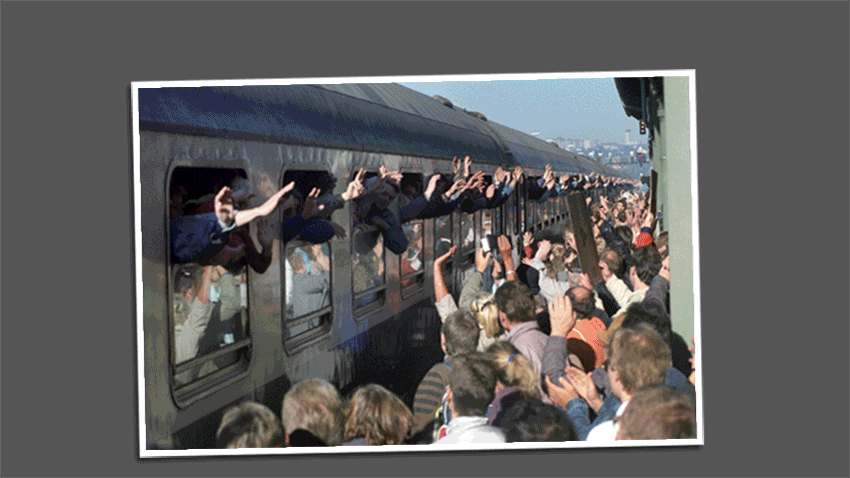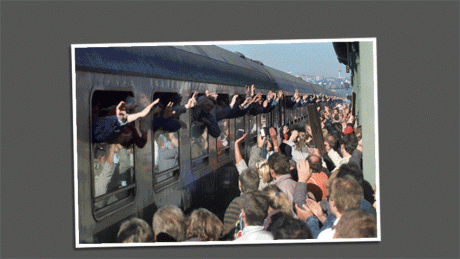“When I left my homeland exactly 26 years ago on the road to
Prague, I had no idea whatsoever that more than two decades later a Wartburg
man like me would end up returning to his old stomping grounds to work as an Opel employee
in Eisenach. Even today I marvel at the thought of it.”
— Frank Hendrich —
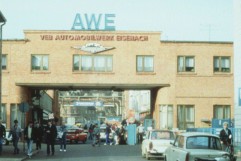
AWE, the manufacturing base of the Wartburg brand in Eisenach.
The German-German story of Opel employee Frank Hendrich begins in September 1989, at a time when the Eastern Bloc is rapidly crumbling. The once immaculate garden of the West German embassy in Prague has been reduced to a muddy field. For weeks it has served as a campground for GDR refugees, who have been climbing the fence of the FRG’s diplomatic outpost in Czechoslovakia in steadily increasing numbers. Their future is uncertain. And Frank Hendrich is one of them. He is 18, a painter, and an employee of AWE at the automobile plant in Eisenach, the manufacturing base of the Wartburg brand. Hendrich has come to Czechoslovakia’s capital city in search of a road to freedom, to the Federal Republic of Germany. “I was young and hungry for life,” he says. The life he and millions of his fellow citizens is seeking cannot be provided by the system behind the Iron Curtain. “Many of my friends and fellow employees had crossed into West Germany, and I didn’t want to be the one left behind to turn out the light.”
MOTOR CITY Eisenach
An industrialist named Heinrich Ehrhardt founded the Eisenach automobile plant in 1896. It produced ordnance, bicycles, and, starting in 1898, the Wartburg motorcar. Numbering 1,300 employees at the turn of the century, the plant was one of Thüringia’s largest concerns. In 1904 the vehicles were rebranded under the name Dixi. And in 1928 the plant was acquired by BMW (Bayerische Motoren Werke AG). It was nationalized and rechristened as VEB Automobilwerk Eisenach after World War II. The Wartburg was manufactured here starting in 1955, producing roughly 1.6 million vehicles. In 1991 the AWE was closed by the privatization agency. Opel opened a factory in Eisenach that same year, thus carrying on Thüringia’s automotive tradition.
“WE HAVE COME TO YOU TODAY…”
Hendrich sees his days at the West German embassy as an adventure: a small traveling bag, no money, and blankets and food from the Red Cross. Once a hometown rebel with a big mouth and sporting Wrangler jeans and Adidas sneakers, picture him trembling and hoping for the final jolt that would topple the GDR. And on 30 September that moment arrives. Shortly before 7 p.m., the Foreign Minister of the FRG, Hans-Dietrich Genscher, appears on the balcony of the Prague embassy in the light of a hastily obtained floor lamp. Raising a megaphone to his mouth, he announces: “We have come to you today to inform you that today your departure…” But Genscher is unable to continue. The cheers of over 5,000 refugees, Hendrich among them, drown him out.
![]()
For weeks the West German embassy in Prague has served as a campground for GDR refugees, who have been climbing the fence of the FRG’s diplomatic outpost in Czechoslovakia in steadily increasing numbers.
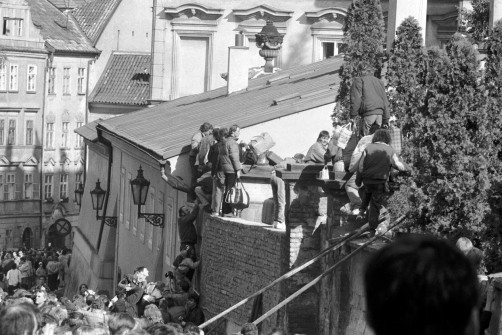
“We have come to you today to inform you that today your departure…” – the Foreign Minister of the FRG, Hans-Dietrich Genscher, appears on the balcony of the Prague embassy.
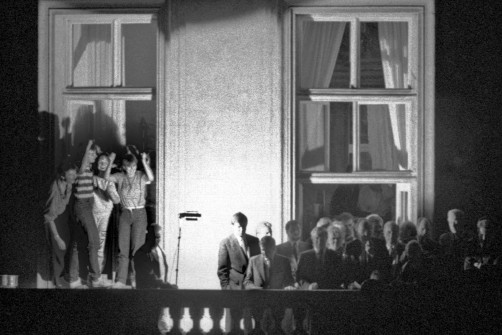
![]()
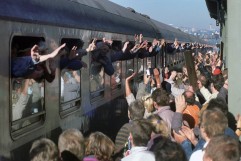
Hendrich boards one of the trains bound for a station in Bavaria’s Upper Franconia region.
That very night, Hendrich boards one of the trains bound for a station in Bavaria’s Upper Franconia region. From there the next stop is a reception camp in Lübeck. “Hugs, kisses, champagne everywhere you turn,” Hendrich recalls. “People were holding up signs on the streets, greeting the new arrivals, welcoming us. It was a dizzying feeling for all of us. Just unbelievable.” His West German odyssey leads at last to a camp run by the Federal Agency for Technical Relief in Gelsenkirchen, a city in the heart of the Ruhr Valley. When the fall of the Berlin Wall on 9 November 1989 brought about the final collapse of the political system of the GDR, Hendrich came across an ad in the newspaper: The automaker Opel was looking for skilled workers for its Bochum plant. “I immediately walked the 15 kilometers to the plant, stopping here and there to hop a streetcar and ride without a ticket.”
A NEW START AT THE FACTORY IN BOCHUM
It goes without saying that when Hendrich arrives at Opel’s HR office, he has neither a résumé nor a cover letter. But he has a skilled worker’s certificate and half an hour to introduce himself. He gets the job. His first day of work is on 2 January 1990. “I was late on day one, because I lost my way in the massive compound. The security guards had a good laugh and showed me the way to my department.”
from Wartburg to Opel
In March 1990, about half a year after Hendrich’s departure, Automobilwerk Eisenach (AWE) and Adam Opel AG agree to work together and build an Opel plant in Eisenach. The socialist automaker transforms into a plant belonging to the GM corporation. In December 1990 Opel acquires a new building plot in Eisenach, where it plans to erect a new automobile assembly plant. The groundbreaking ceremony is held in February 1991, the topping out takes place in September, and production of Astra and Corsa models begins just one year later, on 23 September 1992. At the same time, the automotive plant in Eisenach is undergoing liquidation, and production of the Wartburg is being discontinued.
It is one of the few moments where Frank Hendrich feels like a stranger in his new environment. “Sure, I was nervous, doubtful, and homesick at first,” he admits. West Germany, North Rhine-Westphalia “was a whole new world for me at the time.” But he is impressed and encouraged by the team spirit demonstrated by the Opel employees. Within the first few weeks, several of his coworkers are already visiting him after quitting time. When they see his Spartan living conditions, they tell him they’ll be back at the same time tomorrow. “The guys showed up with a TV, bed linens, and stuff for the kitchen. There were tears in my eyes,” he relates, then goes on to add, “The whole East/West thing that was making waves at the time meant nothing to us. We were Opel workers.”
The 1990s find Hendrich traveling more and more frequently to Thüringia for personal reasons. The prospect of changing places looks better all the time. In 2012 he finally transfers to Opel Eisenach. What has he brought back with him after 22 years in the western reaches of the German Republic? “Above all, the things I had the privilege of experiencing personally in Bochum: openness, the willingness to reach out to others, and a readiness to help.”
first Vectra from Eisenach
The first Vectra stamped ‘Made in Eisenach’ rolls off the assembly line on 5 October 1990. The fact that the car was completed only two days after the GDR joined the German Federal Republic becomes a major news event. Chancellor Helmut Kohl is invited as the guest of honor by Louis R. Hughes, then Chairman of the Board at Opel. In his speech, the chancellor describes Opel’s engagement as a “signal for investments in the new federal states.” A sophisticated logistics system enables production to start quickly in Eisenach. Every other day, a train carrying Vectra parts earmarked for assembly (roughly 1,000 per vehicle) travels from Rüsselsheim to Eisenach. The freight cars are loaded with car body shells manufactured in Rüsselsheim and sets of parts from Kaiserslautern and Bochum. They are assembled in Eisenach.
The first Vectra stamped ‘Made in Eisenach’ rolls off the assembly line on 5 October 1990. Chancellor Helmut Kohl is invited as the guest of honor.
![]()
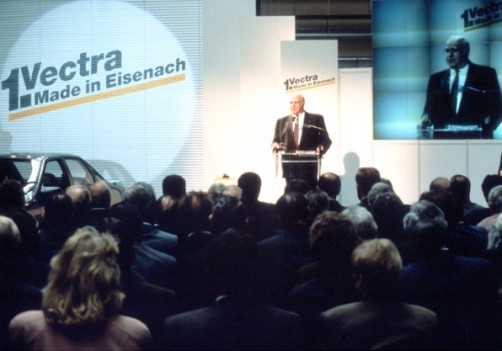
![]()
Opel Eisenach today
Today the Opel plant in Eisenach is one of the most modern automotive manufacturers in the world as regards its environmental friendliness, production technology, and manufacturing system (GM Global Manufacturing System). The plant’s more than 1,400 employees produce four models: Corsa, ADAM, ADAM ROCKS, and ADAM S. Consequently, Opel is the only automaker that not only developed two subcompacts in Germany, but also manufactures them here.
Everything comes full circle in Eisenach, both professionally and personally. “I’m a little proud of that,” says Frank Hendrich. He works in Eisenach as a team representative in the Spot Repair department. He is one of the specialists tasked with rectifying flaws in paint jobs, such as cracks and uneven application. He and his brother Mario belong to a team that competes in the historical Rallye Wartburg with a Wartburg 353. “AWE and Opel: that’s Eisenach. A wonderful development.”
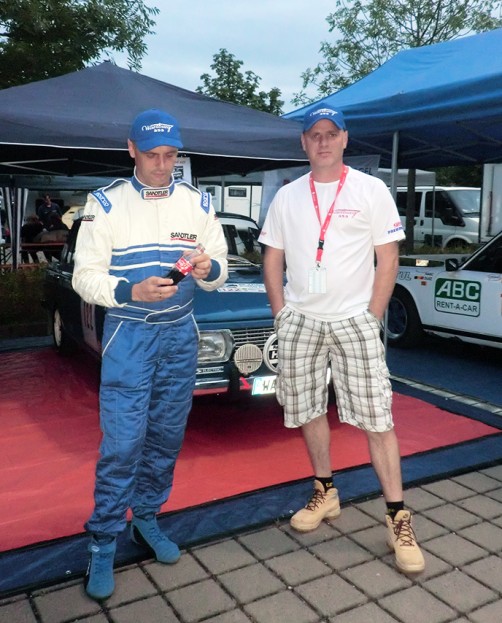
Mario und Frank Hendrich in the historical Rallye Wartburg with a Wartburg 353.
October 2015
